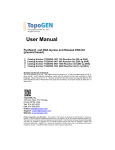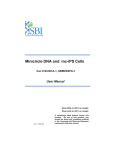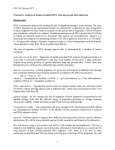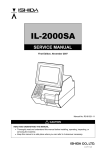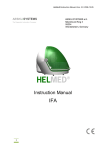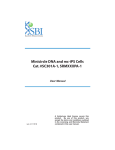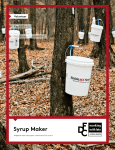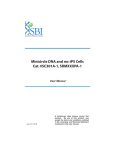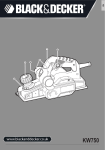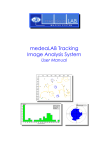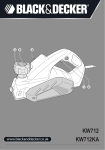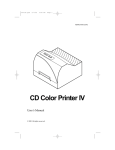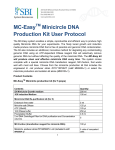Download User Manual - TopoGEN, Inc.
Transcript
© Copyright TopoGEN, Inc., 2011. All rights reserved. User Manual Topoisomerase II Assay Kit (plasmid based). Catalog Number Catalog Number TG1001-1 100 Reaction Set TG1001-2 250 Reaction Set Lot Number: Shipping and Storage of Reagents The kit may be shipped at ambient temperature or on ice (dry ice or wet ice). The DNAs should be stored at 4°C and the buffers stored at -20°C upon receipt. Avoid frequent freeze/thaw cycles with the plasmid as this may contribute to DNA breakage. TopoGEN, Inc. 108 Aces Alley, Port Orange, Florida 32128, USA. Tel: 614-451-5810 Fax: 614-559-3932 Orders [email protected], Support: [email protected] Website: www.topogen.com Product Application and Disclaimer. This product is not licensed or approved for administration to humans or animals. It may be used with experimental animals only. The product is for in vitro research diagnostic studies only. The product in non-infectious and non-hazardous to human health. This information is based on present knowledge and does not constitute a guarantee for any specific product features and shall not establish a legally valid contractual relationship. TopoGEN, Inc. shall not be held liable for product failure due to mishandling and incorrect storage by end user. TopoGEN’s liability is limited to credit or product replacement . Topoisomerase II Assay Kit User Manual I. Introduction A. Summary Human Topoisomerase II (Topo II) exists as two isoforms: p170 (alpha) and p180 (beta). Both isoforms act as type II topoisomerases and will relax superhelical DNA and decatenate kineotoplast DNA (kDNA) from the insect trypanosome, Crithidia fasciculata. The type II enzymes require MgCL2/ATP and will relax DNA in discrete linking number ‘steps’ of two. This is a prototypical eukaryotic enzyme mechanism that will relax either positively or negative supercoiled plasmids, changing DNA linking number in discrete steps of two. Because Topo II is important as a decatenase activity in vivo, it has an acute preference for binding to DNA ‘nodes’ or duplex/duplex crossovers, where it will promote one duplex passage through another intact duplex. In this way, these enzymes are highly proficient at decatenating interlocked DNA rings. This Assay Kit is relatively simple and measures the release of minicircular DNAs by decatenation of an intertangled mass of kDNA. Topo II is especially good at performing this reaction in vitro. The enzyme binds robustly to kDNA networks and rapidly releases intact 2.5 KB monomeric rings. Since kDNA networks are extremely large, they fail to enter a 1% agarose gel. In contrast, the minicircular 2.5 KB rings rapidly migrate into the gel. The released (decatenated) products are somewhat heterogeneous but are predominantly in the form of nicked open circular minicircles and fully closed circular rings. Both are considered decatenation products. Topo II does not induce formation of linear DNA products under the conditions of this assay; therefore, linear kDNA should not be detected in the gels. The Human Topoisomerase II Assay Kit contains reagents necessary to quantify topo II activity in crude cell extracts. Markers are included to allow unambiguous detection of topo II even in the presence of contaminating topoisomerase I. The assay is kDNA based and is highly specific for topo II. Nuclease activity may however cause some degradation of the kDNA substrate. Such degradation will be ATP independent. In addition, nucleases will generate a smear of degradation products in addition to linear kDNA. This kit does not contain enzyme TopoGEN, Inc. www.topogen.com Protocol TG1001 Version 2 032512 Topoisomerase II Assay Kit User Manual (human topoisomerase II is available online by ordering catalog number TG2000H-2). B. Kit Contents (100 assay kit size) 1. kDNA (20 ug total) substrate at the concentration specified on the tube provided. Typically one should use 0.1 to 0.2 ug per reaction. 2. Decatenated kDNA marker (25 ul) in gel loading buffer. Run 2 ul of decatenated DNA marker per gel. 3. Linearized kDNA marker (25 ul) in gel loading buffer; run 2 ul of linear marker per gel. *4. 10x Topo II Incomplete Assay Buffer A: 0.5 M Tris-HCl (pH 8), 1.50 M NaCl, 100 mM MgCl2, 5 mM Dithiothreitol, 300 ug BSA/ml. *5. 10x ATP Buffer B contains 20mM ATP in water. *You must mix Buffers A and B together prior to make a 5x Complete Assay Buffer. To prepare a fresh stock of the 5x Assay buffer: Add equal volumes Buffer A and B (example, if you need 50 ul of 5x Complete Buffer for a single experiment, mix 25 ul of Buffer B with 25 ul of Buffer A). The Complete 5x Buffer should be made fresh for each experiment. Prepare only the amount as needed each day. DO NOT STORE THE 10x COMPLETE ASSAY BUFFER, IT IS NOT STABLE. 6. 5x Stop Buffer/gel loading dye (600 ul): 5x buffer is 5% Sarkosyl, 0.125% bromophenol blue, 25% glycerol. TopoGEN, Inc. www.topogen.com Protocol TG1001 Version 3 032512 Topoisomerase II Assay Kit User Manual C. Protocol for a typical Reaction Mixture of 20 ul Assemble all reactants in the following order. H20: to make up to final volume (20 ul in this case) 5x Complete Reaction Buffer (made 1:1 of A:B) 4 ul DNA 1 ul (250-500 ng is idea for most assays). Test extract: 1 ul (vary as needed) 1. Incubate 30 minutes at 37°C. 2. Stop by addition of 4 ul 5x Stop Buffer. 3. Samples may be loaded directly onto the agarose gel at this point. Optional Step: the samples can be cleaned up by proteinase K digestion o (50 ug/ml for 15 min at 37 C) followed by CIA extraction. For CIA extractions add an equal volume (20 ul) of Chloroform: isoamyl Alcohol or CIA (24:1), vortex briefly; spin in a microfuge for 5 sec. Withdraw blue colored (upper) aqueous phase and load onto agarose gel. CIA extraction will usually improve the cosmetic quality of the agarose gel results. In addition, CIA extraction will extract non-polar compounds that may interfere with the gel staining, with some test drugs. 5. Run a 1% agarose until the dye front (bromophenol blue) is about 4-6 cm down the gel. Do not run overnight as this will cause the DNA bands to diffuse. Usually a gel gives good separation after 30 min or less (we use 4-5V/cm). Stain with 0.5 ug/ml ethidium bromide, destain for 15 min in water and photodocument results. This is a “non-ethidium bromide” gel separation that works well (see gel data, below). You may also run EB containing gels (0.5ug EB/ml) with EB in Gel and Buffer (beware, it is a mutagen, so wear gloves at all times; do not inhale powder). Run gels as above and destain with water for 15 min prior to photodocumenting the results (see Fig. 1 for typical gel result). TopoGEN, Inc. www.topogen.com Protocol TG1001 Version 4 032512 Topoisomerase II Assay Kit User Manual Fig. 1. Typical Topo II reaction products with marker DNAs. A 1% EB containing agarose gel was run. Lane 1: kDNA Catenated DNA marker. Lane 2, kDNA digested with Xho1. Lane 3, kDNA + 4 units topo II with 50 uM Etoposide. Lane 4, same as lane 3 without etoposide. Catenated kDNA Nicked Open Circular Linear kDNA Relaxe d circular 1 2 3 4 D. Important Considerations about this kit. Marker DNAs are extremely important. decatenated and linear kDNA markers. You should always run Any nuclease-free agarose of reasonable quality can be used (from Sigma). A positive control (with known topo II activity) and negative control (no extract) are also very critical for data interpretation. For details on how to make a nuclear salt extract from cells, follow our protocol on the website: http://www.topogen.com/p/methods-protocols.html See “Methods for Extracting Topoisomerases for Enzyme Activity” PDF. Alternatively, purified human topoisomerase IIa is available for purchase (TG2000H-2). Agarose gels (1%) and running buffers can be any standard nondenaturing electrophoresis buffer (example, to prepare a 50x of TAE Gel Buffer: 242 g Tris base, 57.1 ml glacial acetic acid and 100 ml of 0.5 M EDTA). Dilute to 1x to use for gel separations. EB agarose gels (EB at 0.5 ug/ml in gel and buffer) will improve the resolution of cleavage products (nicked open circular kDNA and circular kDNA, see Fig. 1 above). TopoGEN, Inc. www.topogen.com Protocol TG1001 Version 5 032512 Topoisomerase II Assay Kit User Manual Run gels at a relatively high voltage (100-150 v) to facilitate rapid run times. Even if the bromophenol blue goes less than a few cm, you should have sufficient resolution to detect decatenated kDNA products. After running, EB gel should be destained in water or buffer for 15 min prior to photodocumentation. E. Data Interpretation and additional helpful hints. Look carefully at the gels for evidence of kDNA breakdown or degradation, indicating the presence of a nuclease activity (usually not a problem). Activity can be measured by the disappearance of kDNA networks (catenanes) or the formation of decatenated DNA (see Fig. 1). F. Frequently asked questions. What are the critical controls? - Marker DNAs (linear kDNA, decatenated and catenated kDNA) (see Fig. 1) are extremely important. . - Include a negative control (no extract). - Be sure to check solvent effects (if included) or effects of salt (used to extract topo from nuclei). More than 200mM NaCl from the crude extract will impact negatively on the results. What kind of agarose should I buy? Any nuclease-free agarose of reasonable quality from any number of sources can be used (Sigma-Aldrich works). What is the best gel buffer to use? Agarose gels (1%) and running buffers can be any standard nondenaturing electrophoresis buffer (example, to prepare a 50x of TAE Gel Buffer: 242 g Tris base, 57.1 ml glacial acetic acid and 100 ml of 0.5 M EDTA). Dilute to 1x to use for gel separations. Be sure that the gel also has 1x TAE buffer. Why should I run EB gels? In general, Ethidium Bromide (EB) gels are ideal for testing enzyme activity in this system because it is much easier and faster than the non-EB system. Be sure to destain with water for 15 min prior to photodocumenting your data. If the DNA products are poorly resolved, you can simply re-electrophorese until resolution improves. TopoGEN, Inc. www.topogen.com Protocol TG1001 Version 6 032512 Topoisomerase II Assay Kit User Manual What are the running conditions in terms of time and voltage? Run the gels at a relatively high voltage so that the dye front moves 4-5 cm in about 20-30 min. Thus, the gels run rather fast which accelerates the pace of the assay. What reaction volumes do you recommend for these assays? - Reaction volumes should be 20-30 ul final volume (limited by the volume that can be loaded into the wells of the agarose gel). - The reactions should be assembled on ice in microfuge tubes (water, buffer, and DNA, test compound and enzyme, which should be added last). - After adding enzyme, the tubes should be transferred to a heating block to initiate the reaction. Is proteinase K required? Usually it is not necessary; however, if the nuclear extract is concentrated with protein, it may be a good idea to degrade these proteins to improve the cosmetics of your gel. I see two decatenated bands in the gel. Why is that? This is normal when you include EB in the gel system. In the presence of EB, the minicircles resolve out as nicked (ss nick) and intact circular. Both of these are decatenation products and you can quantify either of these to measure topo II. Can you help us with data interpretation? Yes, we can definitely help! The best way to proceed is to send us your data ([email protected]) with a full description of the experiment. We will get back to you quickly with feedback. Any further questions or comments, please feel free to contact us: Email: [email protected] Telephone: 614-451-5810 TopoGEN, Inc. www.topogen.com Protocol TG1001 Version 7 032512








